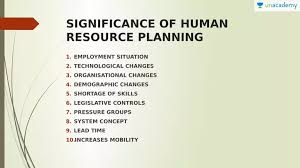Introduction
As told in the last chapter Human resource management has started to play a significant role in the overall strategic development of the organization. At present HR strategies are designed in tune with the overall business strategy of the organization. HR strategy should subserve the interest of the organization, translating the firm’s goals and objectives into a consistent, integrated, and complementary set of programs and policies for managing people.
The first part of Human resource strategy is HRP – Human Resource
Planning. All other HR activities like employee hiring, training and
development, remuneration, appraisal, and labor relations are derived from
HRP.HR planning is important in a wide variety of industries and firms. HR
planning affects what employers do when recruiting, selecting, and retaining
people, and of course, these actions affect organizational results and success.
The challenges caused by changing economic conditions during recent years show
why HR workforce planning should occur.
Staffing and organization is an HR activity that is both
strategic and operational in nature. As the HR Headline indicates, HR planning
is important in a wide variety of industries and firms. HR planning affects
what employers do when recruiting, selecting, and retaining people, and, of
course, these actions affect organizational results and success. Human Resources
planning means different means to different organizations. To some companies,
human resources planning mean management development. It involves helping
executives to make better decisions, communicate more effectively, and know
more about the firm. The purpose of HRP is to make the manager better
equipped for facing the present and future.
Human
Resource Planning (HRP)
![]()
Human resource
planning is important for helping both organizations and employees to prepare
for the future. The basic goal of human resource planning is to predict the
future and based on these predictions, implement programs to avoid
anticipated problems. Very briefly humans resource planning is the process of
examining an organization’s or individual’s future human resource needs for
instance, what types of skills will be needed for jobs of the future compared
to future human resource capabilities (such as the types of skilled employees
you already have) and developing human resource policies and practices to
address potential problems, for example, implementing training programs to
avoid skill deficiencies.
Definition
of Human Resource Planning
![]()
According
to Vetter, “HRP is the process by which management determines how the
organization should move from its current manpower position to desired
manpower position. Through planning, management strives to have the right time,
doing things which result in both the organization and individual receiving
maximum long-run benefits”.
According
to Gordon Mc Beath, “HRP is concerned with two things: Planning of
manpower requirements and Planning of Manpower supplies”.
According
to Beach, “HRP is a process of determining and assuming that the
organization will have an adequate number of qualified persons, available at
proper times, performing jobs which meet the needs of the enterprise and which
provides satisfaction for the individuals involved”
Simply HRP can be understood as the process of forecasting an
organization’s future demands for and supply of the right type of people in the
right number. In other words, HRP is the process of determining manpower needs
and formulating plans to meet these needs.
HRP is a Four-Phased Process.
•
The first
phase involves the gathering and analysis of data through manpower
inventories and forecasts,
•
The second
phase consists of establishing manpower objectives and policies
and gaining top management approval for these.
•
The third
phase involves designing and implementing plans and promotions to
enable the organization to achieve its manpower objectives.
•
The fourth
phase is concerned with the control and evaluation of manpower plans
to facilitate progress to benefit both the organization and the
individual. The long-run view means that gains may be sacrificed in the short
run for future grounds. The planning process enables the organization to
identify what its manpower needs are and what potential manpower problems required
current action. This leads to more effective and efficient performance.
Nature of HRP
![]()
Human resource planning is the process of analyzing and identifying the
availability and the need for human resources so that the organization can meet
its objectives. The focus of HR planning is to ensure that the organization has
the right number of human resources, with the right capabilities, at the right
times, and in the right places. In HR planning, an organization must consider
the availability and allocation of people to jobs over long periods,
not just for the next month or the next year1.
HRP is a sub-system in total organizational planning.
Actions may include shifting employees to other jobs in the organization,
laying off employees or otherwise cutting back the number of employees,
developing
present employees, and/or increase the number of employees
in certain areas. Factors to consider include the current employees’ knowledge,
skills, and abilities and the expected vacancies resulting from retirements,
promotions, transfers, and discharges. To do this, HR planning requires efforts
by HR professionals working with executives and managers.


